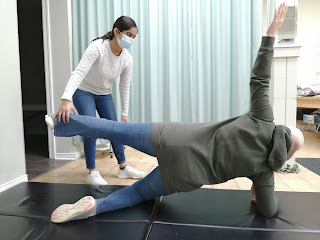Elbow pain
Have you heard of Golfer's elbow (medial epicondylitis) or Tennis elbow (lateral epicondylitis)? Elbow pain is another common pain people have. We certainly see a lot of it at our practice. The funny thing is Golfer's elbow is rarely resulted from playing golf and tennis elbow is rarely resulted from playing tennis. Of course any racket sport can cause upper extremity pain but the most common causes of the elbow pain we see is from lifting and computer use.
We need to address ergonomics for both causes of lifting and computer use. Lifting technique with good posture control is important and can easily be practiced prior to return to work or daily activity. Computer use ergonomics can be a bit more complicated due to it involving more than one items, i.e. computer, desk, chair, keyboard and the mouse. Physiotherapists can help you to arrange your work station that is safe for you to prevent repetitive injuries.
Just like any pain, we need to address the issue of inflammation and tissue healing. Physiotherapists usually use modalities, such as electrotherapy with heat or ice, ultrasound or laser to improve circulation at the injured area. At our practice, we also use hands-on technique, such as myofascial release to improve tissue flexibility and health. Usually our body myofascial tissue fibers get tight from overuse or inflammation. Lengthening the myofascial tissue fibers can help the body circulation increase and reduce pressure on our muscles and nerves. It will allow our muscles to be stretched more easily at lower pain level. Hence it will help our body to heal faster.
Myofascial release technique we use on the elbow and forearm could be hold-and-glide or frictioning on the muscle fibers at the muscle belly. We can also friction at the tendon attachment points on the bone at the elbow, which in anatomy term is called the medial and lateral epicondyles. Sometimes we also use joint mobilization techniques to reduce swelling built up in and around the small joints of the the elbow.
As pain reduces, we will progress exercises from range of motion exercises, to stretching and progress strengthening exercises from isometrics to isotonic and all the while to make sure the shoulders and neck are flexible, strong and stable as well. When the neck and shoulders are not functioning properly, it will affect the movement sequence and force distribution down the biomechanical chain of the upper extremities. We need to take a close look at how the individual use his or her upper body as a whole. Sometimes elbow pain lingers if the biomechanical distress in the up stream, where the shoulder or neck is, is not addressed. Strengthening the shoulder and neck will improve the stability and efficiency of the elbow and wrist use, especially in sports, to prevent injuries.
Let us know if you have lingering elbow pain!





Nice Post..!!
ReplyDeleteFor Online Trusted Medicine seller visit here
What is the Super P-Force used for?
Super P-Force Tablet
What are the side-effects of Super P-Force?
How Can be side-effects of Super P-Force?
The Super P-Force be taken?
How should the Super P-Force be taken?